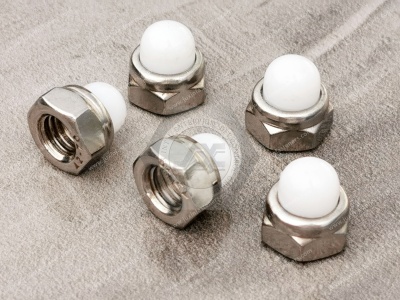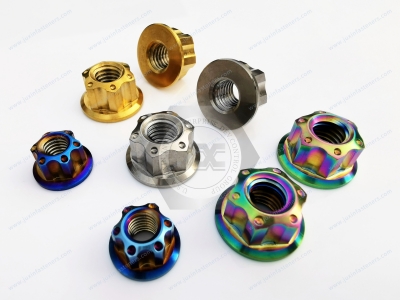Call Us
+86 136 6007 9809
Call Us
+86 136 6007 9809
Jan. 09, 2024
Selection and use of Locknuts Industry Solutions
What is the meaning of anti-loosening nut?
The self-tightening nut is a common fastening locknut, including mechanical anti-loosening, riveting and punching, friction anti-loosening, construction anti-loosening, etc.
Anti Loosening Nut originated in foreign countries; it is a unique engineering plastic permanently attached to the threads so that the internal and external threads, in the process of contraction, the engineering plastic squeeze and produce a strong reaction force, significantly increasing the friction between the internal and external threads, providing an absolute resistance to vibration.
This resistance is thoroughly distributed throughout the engagement section of the inner and outer threads. The friction and the pressure between the inner and outer threads of the shrinkage have nothing to do with the previous method of backstopping, relying on the pressure generated by the screw after the shrinkage of the friction to backstop; once the screw is slightly loose, the pressure is reduced, the friction that is the rapid disappearance of the role of the backstop to lose the screws to come loose. However, due to its environmental impact, the plastic anti-loosening method can not meet high temperature and cold requirements, and new anti-loosening technology must be explored [1].
Thirty-five years ago, the anti-loosening nut was invented in the United States. The traditional 60-degree tip of the tooth has a 30-degree wedge surface; this structure makes the bolt the same as the nut after tightening, and the yin and yang threads will be obtained compared to the traditional threads of greater friction to achieve anti-loosening.
Due to the change in the angle of the tooth shape, the normal force exerted on the contact between the threads is angled at an angle of 60 degrees with the bolt axis instead of 30 degrees, as in the case of ordinary threads. The standard thread pressure is much greater than the fastening pressure; therefore, the resulting anti-loosening friction is bound to increase significantly. When the top of the male thread is biting with the female thread, the tip of the tooth at the top of the tooth is easily deformed so that the load is uniformly distributed in the entire length of the helix in contact, avoiding the phenomenon that more than 80% of the total load is concentrated on the thread surface of the first and second teeth when the ordinary standard thread is biting. Therefore, the threaded coupling overcomes the shortcomings of standard common coupling, which quickly loosens itself under vibration conditions and extends the service life.
Due to this particular tooth deformation, the anti-loosening function can be repeatedly disassembled 5 to 50 times, and it persists. This anti-loosening method has become the most reliable product because of its high vibration resistance, lightweight, and repeatable disassembly.
After the anti-loosening treatment of the screw is called anti-loosening screws, the most suitable for application in the fastening of moving parts, the earliest in the United States on the use of aerospace aircraft, and later promoted to the U.S. automobile manufacturing industry, with the maturity of the manufacturing technology and the reduction of costs, is widely used in the 3C, bicycles, ice skating and skiing equipment, furniture, sports equipment, medical equipment, and other industries, the complete replacement of the traditional stop washer, fully demonstrating the anti-loosening screws, tightening anti-loosening role. Screws of the tightening of the role of anti-loosening can be relied upon.
Metric High-Strength Steel Nylon-Insert Flange Locknuts—Class 10
A nylon insert firmly grips threads to resist loosening, and a flange distributes the load over a large area. They're reusable, but their holding power lessens with each use. Made from Class 10 steel, they're about 25% stronger than medium-strength steel flange nuts and comparable in strength to Class 10.9 bolts. They have a zinc or zinc-yellow-chromate plating to resist corrosion in wet environments. Height includes the flange. Metric Stainless Steel Nylon-Insert Flange Locknuts。 Made from 18-8 stainless steel, these flange locknuts have good chemical resistance and may be mildly magnetic. A nylon insert firmly grips threads to resist loosening, and a flange distributes the load over a large area. They're reusable, but their holding power lessens with each use. Height includes the flange. Metric 18-8 stainless steel is also known as A2 stainless steel.
The method of anti-loosening
Anti-loosening nut is the nut, and bolts or screws screwed together used to play a fastening role in the parts; all production and manufacturing machinery must be used in an original, anti-loosening nut is the mechanical equipment will be tightly connected to the parts, through the inner threads, the exact specifications of anti-loosening nuts and screws, to be connected, the following details for you to introduce the anti-loosening nut to avoid slipping loose four kinds of methods.
One mechanical anti-loosening: Use the lock nut stopper to limit the relative rotation of the lock nut vice directly, such as using the start pin, string steel wire stop washers, etc. As the lock nut stops no preload, the lock nut loosens to the stop position when the anti-loosening stops playing a role. Therefore, the lock nut this way, in practice, is not anti-loosening but to avoid zero falls.
2. Rivet punch anti-loosening: in the tightening of the punch point, welding, bonding, and other methods, the locking nut vice loses the characteristics of the movement and articulation of the non-removable articulation. The defect of this way is that the bolt can only be used once, and the disassembly is complicated; the need to destroy the bolt side can be disassembled.
3. Friction anti-loosening: this is one of the most widely used anti-loosening ways. This way, the locking nut between the vice produces a positive pressure that does not change with the external force to make a locking nut to prevent the relative rotation of the friction force. This positive pressure can be axial or simultaneous two-way compression of the lock nut vice to complete, such as elastic washers, double nuts, self-locking nuts, and inserts lock nuts.
4. Construction of anti-loosening: This is the application of the lock nut vice its structure, that is, Tang's lock nut anti-loosening method.
5. Punching method of anti-loosening: after tightening the nut at the end of the thread punch point to destroy the thread; bonding anti-loosening usually use an anaerobic adhesive binder coated on the surface of the threads screwed together, tighten the anti-loosening nut after the adhesive can be cured by itself, the anti-loosening effect is good. The disadvantage of this method is that the bolts can only be used once, the disassembly is complicated, and the bolt vice can be dismantled.


Advantages of anti-loosening nut
1. Superior anti-vibration performance: When the threads are tightened, the thread line of the top of the bolt is drawn into the 30° wedge angle of the nut, and the normal force exerted on the wedge slope is at an angle of 60° with the axis of the bolt, not 30°, so the normal force generated when the anti-loosening nut is tightened much greater than that of an ordinary standard nut, which has excellent anti-loosening and anti-vibration capability. The anti-loosening nut adopts a unique structural design, which can resist the influence of vibration force and gravity, effectively avoiding the nut loosening and ensuring the stable operation of the equipment.
2. Strong wear resistance and shear resistance: The 30°beveled surface of the bottom of the nut threads enables the locking force of the nut to be uniformly distributed on the threads of all the teeth. Since the compression force on the threaded surface of all the teeth is uniformly distributed, the nut can better solve the problems of thread wear and shear deformation.
3. Good reuse performance: Many uses show that the anti-loosening nut's locking force is still not reduced to maintain the original locking effect after repeated fastening and disassembly.
The selection and correct use of locknuts is crucial to the safety and reliability of threaded connections.
Selection and Classification of Anti-Loosening Nuts
1. Material Selection: Select the appropriate material for the jam nut according to the actual use scenario and requirements. Different materials have different corrosion resistance and strength characteristics.
2. Size matching: Select the locknuts that match the thread size of the connected fasteners. Ensure that the size and pitch of the threads are consistent to ensure that the connection is correct and fastening.
Loose nuts are mainly divided into elastic locknuts, locking locknuts, adhesive locknuts, and so on. Elastic locknuts use the principle of elastic deformation to force the nut to tighten on the connected part. Locking jam nuts utilizes the effect of high friction so that once the nut is tightened, it will not loosen. On the other hand, adhesive locknuts are coated with a layer of sticky substance that forms an adhesive layer with high affinity after tightening to prevent the nut from loosening.
Installation and use of jam nuts
1. Appropriate torque: Use the correct torque tool and torque value when installing locknuts. Ensure the torque is moderate, not excessive or too small, so as not to affect the effectiveness and reliability of the threaded connection.
2. Regular inspection: Check the fastening status and loosening of the jam nut regularly. This is especially important in the case of long-term use or the influence of a vibration environment.
3. Use of environmental considerations: When selecting and using anti-loosening nuts, consider the working environment. For example, in a high-temperature, high-humidity, or chemical corrosion environment, select the nuts with the appropriate anti-corrosion properties.
The selection and proper use of locknuts are the key to ensuring the safety of threaded connections. Appropriate selection and fair use can improve the threaded connection's reliability and stability and ensure the equipment's normal operation. Regular inspection and maintenance of the jam nut can be found promptly, and the problem of loosening must be solved to ensure the connection has been maintained in a tight state.
Application industries of anti-loosening nuts
Anti-loosening nuts are widely used in machinery, engineering, construction, and other fields, especially suitable for vibration-frequent occasions, such as automobiles, airplanes, ships, machine tools, mines, electric power, chemical industry, and other industries. In these fields, using anti-loosening nuts can significantly improve the reliability and safety of the equipment, reduce maintenance and repair work, and reduce equipment failure rate and production costs.
In short, the anti-loosening nut is a convenient fastener widely used in machinery, automobiles, aerospace, chemicals, and other fields. Its appearance effectively solves problems such as nut loosening and improves equipment safety and reliability.
If you are looking for high-quality nuts fasteners or technical support for structural design, you are welcome to contact me. Thanks.Email:adelajonly@gmail.com
Website: https://www.juxinfasteners.com
Contact Us
Tel.:
+86 020 8621 0320
+86 020 3121 6067
Technical Support:
Navigation
SEND INQUIREY